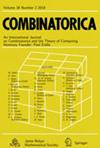从$$\chi$$-有界性分离多项式$$\chi$$-有界
IF 1
2区 数学
Q1 MATHEMATICS
引用次数: 18
摘要
从Carbonero、Hompe、Moore和Spirkl最近的论文中扩展了这一观点,对于每一个函数\(f:\mathbb{N}\rightarrow\mathbb{N}\cup\{\infty\}\),其中\(f(1)=1\)和\(f{c}3n+1\\3\end{array}}\right),我们构造了一类图的遗传类({\mathcal{G}),使得团数为n的图({\ mathcal{G}})中的图的最大色数对于每个图(n \ in\mathbb{n}\)等于f(n)。特别地,我们证明了图的遗传类是有界的,但不是多项式有界的。本文章由计算机程序翻译,如有差异,请以英文原文为准。
Separating Polynomial $$\chi $$ -Boundedness from $$\chi $$ -Boundedness
Extending the idea from the recent paper by Carbonero, Hompe, Moore, and Spirkl, for every function \(f:\mathbb {N}\rightarrow \mathbb {N}\cup \{\infty \}\) with \(f(1)=1\) and \(f(n)\geqslant \left( {\begin{array}{c}3n+1\\ 3\end{array}}\right) \), we construct a hereditary class of graphs \({\mathcal {G}}\) such that the maximum chromatic number of a graph in \({\mathcal {G}}\) with clique number n is equal to f(n) for every \(n\in \mathbb {N}\). In particular, we prove that there exist hereditary classes of graphs that are \(\chi \)-bounded but not polynomially \(\chi \)-bounded.
求助全文
通过发布文献求助,成功后即可免费获取论文全文。
去求助
来源期刊

Combinatorica
数学-数学
CiteScore
1.90
自引率
0.00%
发文量
45
审稿时长
>12 weeks
期刊介绍:
COMBINATORICA publishes research papers in English in a variety of areas of combinatorics and the theory of computing, with particular emphasis on general techniques and unifying principles. Typical but not exclusive topics covered by COMBINATORICA are
- Combinatorial structures (graphs, hypergraphs, matroids, designs, permutation groups).
- Combinatorial optimization.
- Combinatorial aspects of geometry and number theory.
- Algorithms in combinatorics and related fields.
- Computational complexity theory.
- Randomization and explicit construction in combinatorics and algorithms.
 求助内容:
求助内容: 应助结果提醒方式:
应助结果提醒方式:


